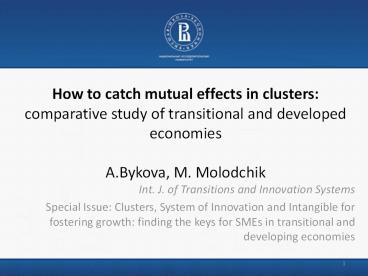Int. J. of Transitions and Innovation Systems
Title:
Int. J. of Transitions and Innovation Systems
Description:
Porter s cluster theory (competition and institutional systems). The concept of relational capital (strong and frequently ties, both formal and informal). –
Number of Views:61
Avg rating:3.0/5.0
Title: Int. J. of Transitions and Innovation Systems
1
How to catch mutual effects in clusters
comparative study of transitional and developed
economiesA.Bykova, M. Molodchik
- Int. J. of Transitions and Innovation Systems
- Special Issue Clusters, System of Innovation and
Intangible for fostering growth finding the keys
for SMEs in transitional and developing economies
2
AGENDA
- Idea
- Methodology
- Results
- Implication
3
Keywords
- cluster,
- mutual effects,
- innovation capability,
- economic value added,
- system of innovation
4
the most comprehensive theories of clusters
- Agglomeration theory (spatial proximity).
- Porters cluster theory (competition and
institutional systems). - The concept of relational capital (strong and
frequently ties, both formal and informal). - According to the aim of the paper, in each of
these directions we focus on two aspects
innovation capabilities and companys value
growth.
5
Cluster is a group of different-sized competitive
companies, mostly operating in one industry,
with
- Spatial proximity (concentrating in one region)
- and
- Strong local ties with industry partners
(including competitors) and/or different
non-market actors, such as universities, venture
funds, governments, business-associations etc.
6
The differences in cluster strength for
transitional and developed economies
7
(No Transcript)
8
The Research framework for the investigation of
mutual effects in transitional countries
9
Hypotheses
- Hypothesis 1 Cluster participation has a
positive influence on innovation capability.
Effects are much stronger for developed
countries. - Hypothesis 2 With controls for the countrys
type and the companys size, a companys value
growth will increase with the strength of the
cluster.
10
Regression 1
Independent variables Dependent variables and specifications Dependent variables and specifications
Independent variables Intangibles (Panel A) Patents (Panel B)
Location in Cluster 95.18 (3.01) 12.74 (2.28)
Internal factors Internal factors Internal factors
Age -1.12 (-2.38) -0.06 (-0.73)
Belonging to catching-up countries 1266.56 (3.75) -124.12 (-2.08)
Location in megalopolis 73.60 (2.12) 6.28 (1.02)
Belonging to medium sized companies 0.041 (12.70) 0.002 (3.28)
Industry factors Industry factors Industry factors
Public RD expenses in industry 12607.64 (6.28) 848.33 (2.37)
Business RD expenses in industry -1970.33 (-5.38) -188.94 (-2.92)
Environment factors Environment factors Environment factors
Efficiency Drivers 1915.63 (6.37) 146.40 (2.75)
Innovation and Sophistication Factors 1104.80 (7.53) 55.52 (2.14)
Constant -10227.94 (-6.20) 210.94 (0.72)
Adjusted R-squared 0.21 0.07
F-statistic 33.83 10.68
Prob (F-statistic) 0.000000 0.000000
Number of observations 1130 1130
11
Regression 2
Independent variable Economic Value Added (EVA) Economic Value Added (EVA)
Independent variable ß-coefficient t-statistic
Location in Cluster 41.74 (3.68)
Internal factors Internal factors Internal factors
Age 0.03 (0.20)
Location in megalopolis 31.19 (2.41)
Belonging to catching-up countries -246.20 (0.34)
Belonging to medium-sized companies -0.005 (-3.84)
Patents -0.06 (-0.89)
Industry factors Industry factors Industry factors
Public RD expenses in industry 2072.98 (0.83)
Business RD expenses in industry -531.59 (-0.95)
Environment factors Environment factors Environment factors
Innovative SMEs collaborating with others 7.45 (2.11)
Subsidiaries presence -0.19 (-3.40)
Frequently dialogue with partners 157.98 (1.12)
Brand 29.90 (1.59)
Global Competitiveness Index 8.16 (0.24)
Constant -891.44 (-0.98)
Adjusted R-squared 0.067 0.067
F-statistic 5.80 5.80
Prob (F-statistic) 0.000000 0.000000
Number of observations 975 975































